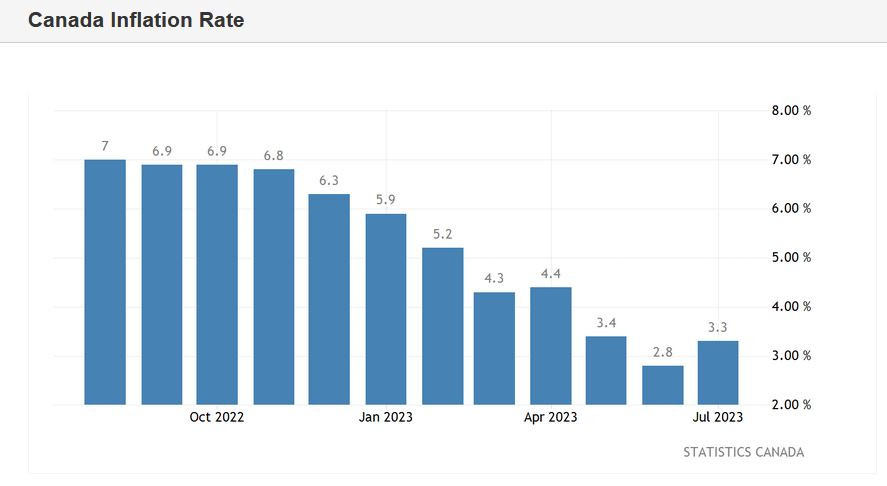The Canadian dollar has been losing ground against its American peer. Yesterday, USD/CAD buyers updated a multi-week high and tested the levels above 1.36. The last time the currency pair was in this price area was late May this year. After an impulsive bounce, the loonie corrected downward. However, this correction was of a technical, temporary nature on the back of a suddenly weakened greenback. Today, USD/CAD bulls have returned to the big game: the price bounced off the support level of 1.3510 (the Tenkan-sen line on the D1 timeframe) and again headed towards 1.36. If Jerome Powell does not sink the US currency tomorrow, the instrument will most likely settle above the 1.3600 target in the very near future. At least, the prevailing fundamental background contributes to the development of such a scenario.

Notably, the Canadian dollar is losing its positions against the backdrop of accelerating inflation in Canada. Last week, on August 15, traders found out Canada's consumer price index for July. The headline CPI rose to 0.6% on a monthly basis, twice faster than the expected growth to 0.3%. In annual terms, the index climbed to 3.3%, while most experts predicted growth to 3.0%. The CPI showed acceleration for the first time after many months of a protracted decline. The core consumer price index also came out in the "green zone": on a monthly basis, the indicator left the negative area and rose to 0.5% (forecast - 0.4%). In annual terms, the core CPI remained at the June level of 3.2% in July, while analysts had forecast a decline to 2.8%.
On the one hand, the published figures turned out to be on the side of the Canadian dollar as they reflected the upward dynamics of many components in the inflation report. On the other hand, the report did not reinforce hawkish expectations of further policy moves of the Bank of Canada. In particular, according to experts from TD Securities, the July rise in inflation in Canada "is clearly not enough to tip the scales in the direction of another increase in interest rates." In their opinion, the Bank of Canada will keep interest rates at 5.00% probably until 2024 provided that CPI growth does not become sustainable.
A similar prediction was voiced by many other analysts, reflecting, in fact, the general opinion of market participants. That is why after the publication of the inflation report, USD/CAD continued to go up.
The "inconclusive" rise in inflation is not the only argument in favor of maintaining the status quo by the Canadian regulator. After all, here we can also recall the latest release in the field of the labor market, almost all components of which disappointed. For example, the unemployment rate in Canada inched to 5.5% from a previous reading of 5.4%. The growth is minimal, but in this case, a certain negative trend is unfolding. Indeed, the jobless rate has been consistently growing over the past three months. The increase in the number of employees was also disappointing. Experts predicted an increase of 25,000 in July, while real figures showed a negative trend. During the second month of summer, the number of jobs decreased by 6,000. The indicator was again in the negative area (-6.4K) after a significant rise (59.9K) in June. Yesterday another macroeconomic report was published in Canada, which also turned out not to be on the side of the loonie. The volume of retail sales (excluding motor vehicles) decreased sharply by 0.8% (against the forecast of growth by 0.3%). This is the worst reading since February this year. Including car sales, retail sales in Canada rose marginally by 0.1%.


Let me remind you that the Bank of Canada when deciding to raise the rate in July, made it clear that this step could be the last in the current cycle of monetary tightening. According to the Governor of the Central Bank, Tiff Macklem, the further steps of the regulator "will be determined by the assessment of incoming data and the prospects for inflation."
The current fundamental background contributes to the further development of the uptrend in US/CAD on the condition that Jerome Powell doesn't play the black swan tomorrow. If the Fed Chairman maintains hawkish rhetoric in Jackson Hole, being also worried about an unexpected increase in the general consumer price index and an increase in the producer price index in the US, the loonie can not only test but also settle at about 1.36.
Technical analysis also speaks in favor of the uptrend. On the daily chart, the instrument is between the middle and upper lines of the Bollinger Bands indicator, as well as above all the lines of the Ichimoku indicator, which formed a bullish Line Parade signal on D1. This indicates the priority of long positions on downward retracements. The main target of the medium-term uptrend is 1.3650, which is the upper line of the Bollinger Bands indicator on the daily chart.
The material has been provided by InstaForex Company - www.instaforex.comfrom Forex analysis review https://ift.tt/jotFG6v
via IFTTT
